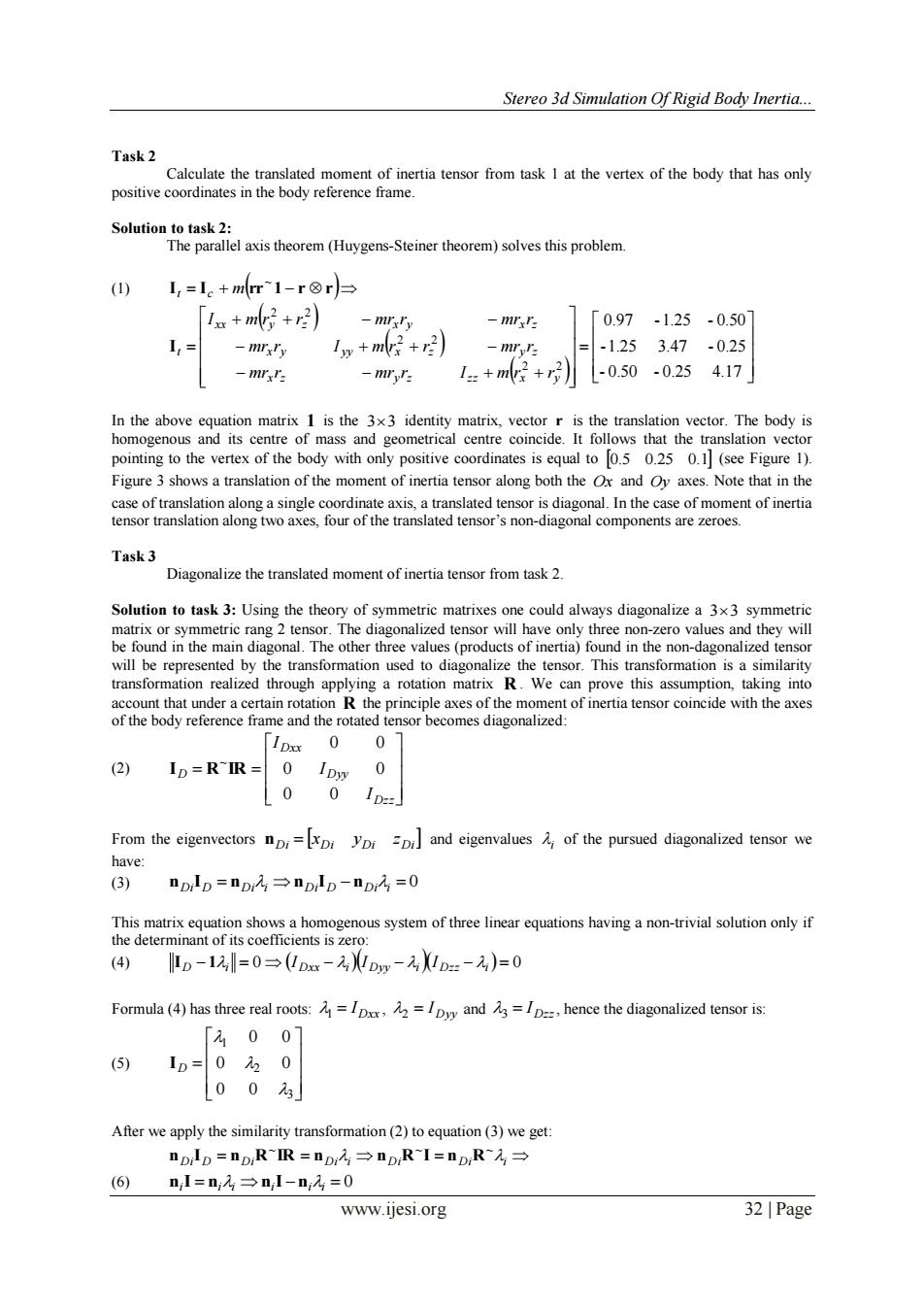正在加载图片...

Stereo 3d Simulation Of Rigid Body Inertia... Task 2 Calculate the translated moment of inertia tensor from task I at the vertex of the body that has only positive coordinates in the body reference frame. Solution to task 2: The parallel axis theorem(Huygens-Steiner theorem)solves this problem. (1) L,=Ie+mr1-r⑧r→ 1+m+2) -mrxry -mrxr: 0.97 -1.25-0.507 2 mrxry 1y+m2+2 -1.253.47 -0.25 -mrxr: -mryr: 1+m2+3 -0.50 -0.254.17 In the above equation matrix 1 is the 3x3 identity matrix,vector r is the translation vector.The body is homogenous and its centre of mass and geometrical centre coincide.It follows that the translation vector pointing to the vertex of the body with only positive coordinates is equal to 0.5 0.25 0.1(see Figure 1). Figure 3 shows a translation of the moment of inertia tensor along both the Ox and Oy axes.Note that in the case of translation along a single coordinate axis,a translated tensor is diagonal.In the case of moment of inertia tensor translation along two axes,four of the translated tensor's non-diagonal components are zeroes. Task 3 Diagonalize the translated moment of inertia tensor from task 2. Solution to task 3:Using the theory of symmetric matrixes one could always diagonalize a 3x3 symmetric matrix or symmetric rang 2 tensor.The diagonalized tensor will have only three non-zero values and they will be found in the main diagonal.The other three values(products of inertia)found in the non-dagonalized tensor will be represented by the transformation used to diagonalize the tensor.This transformation is a similarity transformation realized through applying a rotation matrix R.We can prove this assumption,taking into account that under a certain rotation R the principle axes of the moment of inertia tensor coincide with the axes of the body reference frame and the rotated tensor becomes diagonalized: 0 0 (2) ID=RIR= 0 Ipyy 0 0 0 ID:> From the eigenvectors p and eigenvalues of the pursued diagonalized tensor we have: (3) nDlD=nDi→nDlD-nDA=0 This matrix equation shows a homogenous system of three linear equations having a non-trivial solution only if the determinant of its coefficients is zero: (4) D-1,l=0→(0p-0Dw-AuDe=-)=0 Formula(4)has three real roots:=IDx,=IDyy and=ID=,hence the diagonalized tensor is: [2 0.0 (5) 1D= 0 2 0 0 03 After we apply the similarity transformation(2)to equation(3)we get: nDiID=npRR=nDi→nDRI=nDRA→ (6) nl=n;→nl-n4=0 www.ijesi.org 32 PageStereo 3d Simulation Of Rigid Body Inertia... www.ijesi.org 32 | Page Task 2 Calculate the translated moment of inertia tensor from task 1 at the vertex of the body that has only positive coordinates in the body reference frame. Solution to task 2: The parallel axis theorem (Huygens-Steiner theorem) solves this problem. (1) It Ic mrr ~ 1 r r - 0.50 - 0.25 4.17 -1.25 3.47 - 0.25 0.97 -1.25 - 0.50 2 2 2 2 2 2 x z y z z z x y x y yy x z y z xx y z x y x z t mr r mr r I m r r mr r I m r r mr r I m r r mr r mr r I In the above equation matrix 1 is the 33 identity matrix, vector r is the translation vector. The body is homogenous and its centre of mass and geometrical centre coincide. It follows that the translation vector pointing to the vertex of the body with only positive coordinates is equal to 0.5 0.25 0.1 (see Figure 1). Figure 3 shows a translation of the moment of inertia tensor along both the Ox and Oy axes. Note that in the case of translation along a single coordinate axis, a translated tensor is diagonal. In the case of moment of inertia tensor translation along two axes, four of the translated tensor’s non-diagonal components are zeroes. Task 3 Diagonalize the translated moment of inertia tensor from task 2. Solution to task 3: Using the theory of symmetric matrixes one could always diagonalize a 33 symmetric matrix or symmetric rang 2 tensor. The diagonalized tensor will have only three non-zero values and they will be found in the main diagonal. The other three values (products of inertia) found in the non-dagonalized tensor will be represented by the transformation used to diagonalize the tensor. This transformation is a similarity transformation realized through applying a rotation matrix R . We can prove this assumption, taking into account that under a certain rotation R the principle axes of the moment of inertia tensor coincide with the axes of the body reference frame and the rotated tensor becomes diagonalized: (2) Dzz Dyy Dxx D I I I 0 0 0 0 0 0 ~ I R IR From the eigenvectors nDi xDi yDi zDi and eigenvalues i of the pursued diagonalized tensor we have: (3) nDiID nDii nDiID nDii 0 This matrix equation shows a homogenous system of three linear equations having a non-trivial solution only if the determinant of its coefficients is zero: (4) ID 1i 0 IDxx i IDyy iIDzz i 0 Formula (4) has three real roots: Dxx I 1 , Dyy I 2 and Dzz I 3 , hence the diagonalized tensor is: (5) 3 2 1 0 0 0 0 0 0 ID After we apply the similarity transformation (2) to equation (3) we get: nD iID nD iR ~ IR nD ii nD iR ~ I nD iR ~ i (6) ni I nii ni I nii 0